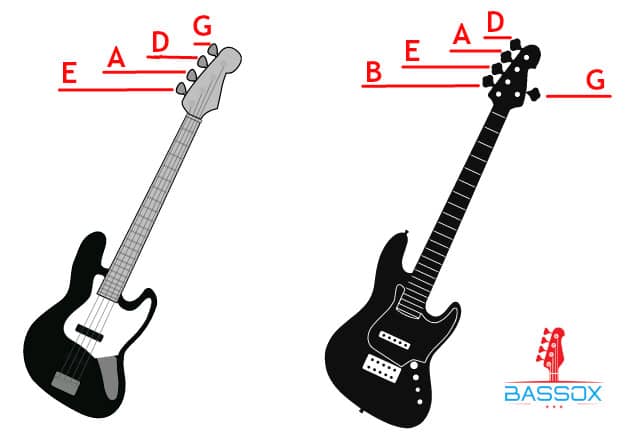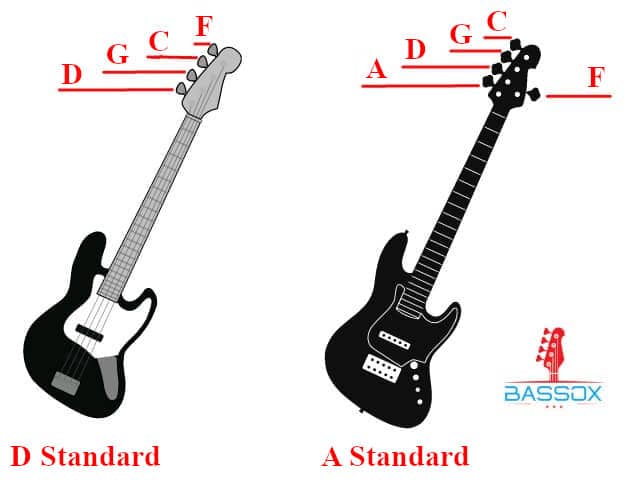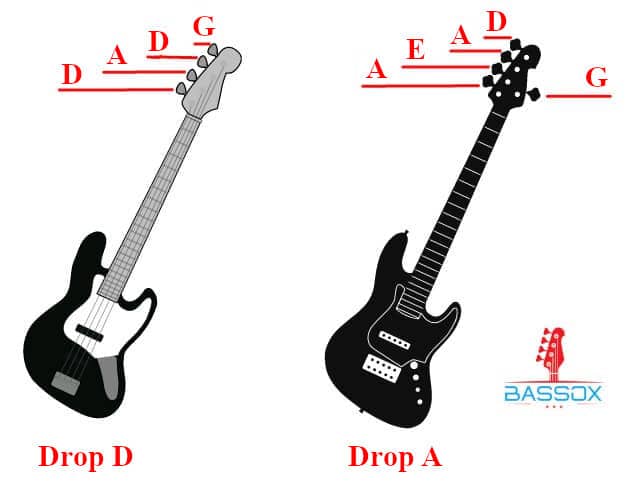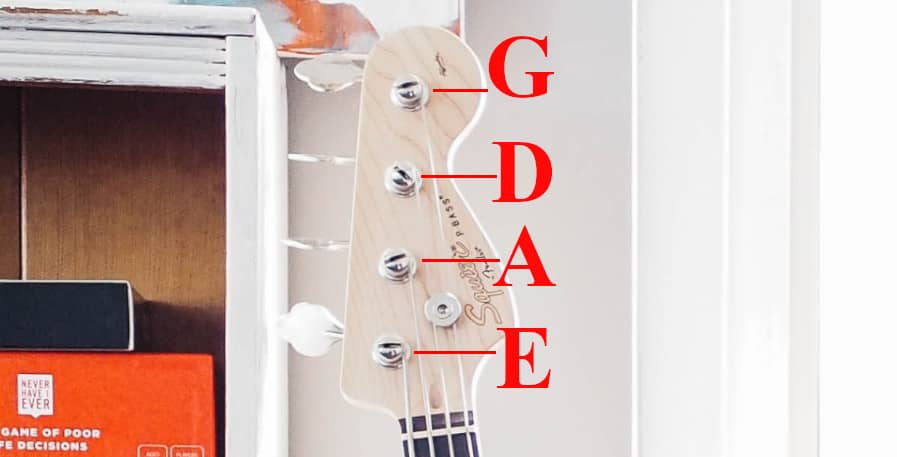Knowing the name of each bass string is paramount for bass players. However, as a beginner, it can be hard to remember the name of each of them.
Therefore, I`ve written this article to help you out with just that.
First, we`ll take a look at the name of the bass strings on 4, 5, and 6-string basses. Then I`ll show you an easy trick for easily remembering each of them.
Lastly, I`ll show you some situations where the names of the bass strings change. I`ll also cover why this happens, and how to remember string names in alternate tunings.
Name of bass strings on 4,5 and 6-string basses
From deepest to highest, the strings on a 4-string bass are named E-A-D-G. 5-string basses have an additional deep string and they are thus called B-E-A-D-G. 6-string basses have an additional high string, which results in them being named B-E-A-D-G-C.

The name of the string simply refers to what pitch it makes when the open string rings out.
When talking about tunings and the name of bass strings, it`s common to list them from deepest to highest. Thus, on a 4-string bass, E is the name of the thickest string, whereas G is the thinnest.
Furthermore, there are just 12 musical notes. However, these can all be played at either a deep or a high pitch. This is why the name of the strings on a bass descends in alphabetical order but rises in pitch.
| String Name: | Open String Pitch: | Frequency: |
| E-String | E1 | 41.2Hz |
| A-String | A1 | 55.0Hz |
| D-String | D2 | 73.4Hz |
| G-String | G2 | 98.0Hz |
It`s also helpful to know that the thinnest string on basses and guitars is called the first string. Thus, on a 4-string bass, the G is called the first string, and the E is called the 4th string.
This can lead to some confusion, as the names of the strings are commonly listed from deepest to highest. In other words, we are listing them 4th-3rd-2nd-1st.
When I first started out, this lead to me having to “flip” how I thought about the strings when numbering them. Thus, I personally refer to them by their name, or as “the deepest or thinnest” to avoid any confusion.
How to remember the name of the bass strings
When starting out, it can be helpful to memorize a phrase in order to remember the name of each bass string.
In these phrases, the first word of each letter corresponds to the name of a bass string. For example, Elephants Are Definitely Grand; E-A-D-G.
Thus, if you remember the phrase, you also remember the name of the strings. Here are some other phrases. Feel free to use whichever you find the easiest to remember.
- Each accord does great
- Elks and dogs bark
- Eat a donut Gary
If you play a 5-string, you also need to remember that the lowest string is a B. In order to do that, here are some phrases that are specific to the 5-string bass.
- Bruce eats a delicious grape
- Bring eggs and donuts Gary
- Bald Eagles are Definitely Gorgeous
After using this trick for a while, you will start to remember the name of the strings by heart. At that point, the line will have served its purpose, and you will intuitively be able to remember the name of each bass string.
Standard tuning
All of the above information is applicable to basses in E standard tuning. This is the most common tuning for basses, and unless other information is provided it`s safe to assume a bass is tuned this way.
However, sometimes basses are tuned in other standard tunings than E. As this changes the pitch of the strings, it also changes what names we use for them. For example, in D standard bass tuning, the strings are called D-G-C-F.

First off, it`s important to identify when basses might be tuned this way. One instance is when finding tabs or notes for a song, and noticing that it is originally played in an alternate tuning.
Another is when playing with other people, as their original music or cover songs might be played in a different tuning than E standard.
As for remembering the name of the strings, there are two main methods I found helpful.
One method was to simply remember E-A-D-G and transpose each letter down the correct amount of steps in my head. This works because every string is always tuned at a perfect fourth interval from one another in all standard tunings.
Another way was to think of a new phrase for the tuning. For example, when playing in D standard, I might remember the phrase David Goes Clubbing Frequently.
Alternate tunings are most common in metal and hard rock, though they have seen some use in everything from pop to jazz. In most genres, alternate tunings are not very common, but it is helpful to be aware that basses are not always tuned E-A-D-G.
Tuning down your bass – Basses can simply be tuned down by turning the tuning pegs on it, and matching their pitch to a different tuning than E standard. Deeper tunings might however require you to change strings and get the bass set up to fit the new tuning.
Drop Tuning
Lastly, some alternate tunings break with the perfect fourth pattern of standard bass tunings. This is most commonly happens when bands elect to play in a drop tuning.
Drop tunings resemble standard tunings, but tune down the deepest string an additional whole step. We also name drop tunings according to the pitch of the deepest string. As a result, the strings in Drop D are named D-A-D-G.

This is different from standard tunings, where every string is tuned a perfect fourth apart. In a drop tuning, the two deepest strings are now tuned a perfect fifth apart instead.
Thus, Drop D resembles E standard as the 3 highest strings are called A-D-G. However, it`s called Drop D due to the deepest string being “dropped” from an E to a D.
Most of what I said about alternate standard tunings can be said of drop tunings as well. Similar to standard tunings, drop tunings are most common in heavier music genres.
The best way to remember them is also to either think of a new phrase to remember the tuning. You can also transpose it in your head, though this is slightly harder as the deepest string has to be transposed down 2 additional steps.
Conclusion
Luckily, alternate tunings are not something you have to concern yourself with when starting out as a bassist. Remembering E-A-D-G, with the help of a phrase that is easy to memorize is all you need to get started.
It won`t take long either before the name of the strings become ingrained and you`ll always remember them from the top of your head.
When the name of the strings becomes second nature, the next step is to start memorizing the other notes on the fretboard. What worked best for me, was to do so by using the fret markers on my bass.
To learn more about how to do the same, check out my article on What the dots on a bass mean. It will give you a simple introduction to memorizing the rest of the fretboard of your bass.

